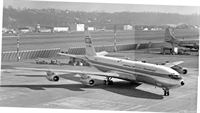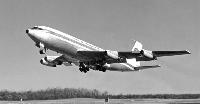Фотографии
-
Регистрационный номер: N761PA [7] With the starboard wing repaired and a new No 4 engine fitted, N761PA was returned to Pan Am, with which it served until the spring of 1977, when it was acquired by Philippine airline Air Manila International. The airline continued to operate scheduled services with the long-serving 707 until it was withdrawn in early 1981.
Самолёты на фотографии: Boeing Boeing 707/720 - США - 1954
-
Регистрационный номер: N761PA [7] A rare photograph of 707 N761PA at the Boeing factory at Renton, near Seattle, before joining Pan Am in June 1962. The aircraft was the second production 707-320B (designated -321B in Pan Am service), the new variant replacing the 320’s turbojets with turbofans and an improved wing of increased span and reduced drag.
It’s always the one in the background that’s a puzzle, isn’t it - the rear-loading modified Stratofreighter, partly visible in this detail from our TAH 13 picture of Boeing 707 N761PA at Renton, is YC-97A 45-59593.Самолёты на фотографии: Boeing Boeing 707/720 - США - 1954
-
Регистрационный номер: N761PA [7] Another photograph of N761PA at Heathrow in February 1963, before it became famous for its role in the dramatic events over San Francisco in 1965. Note the ventral fin on the fuselage, added to some 707 models in order to improve lateral stability and prevent over-rotation during take-off.
Самолёты на фотографии: Boeing Boeing 707/720 - США - 1954
-
Регистрационный номер: N761PA [7] Jet Clipper Friendship at Heathrow in February 1963, while operating on Pan Am’s transatlantic service. By the summer of 1965 N761PA had been transferred to Pacific operations and was a regular on the San Francisco-Honolulu service.
Самолёты на фотографии: Boeing Boeing 707/720 - США - 1954
-
The undercarriage of a Pan Am 707 is pulled up sharpish as it roars away in this airline publicity still. Pan Am inaugurated its jetliner service between San Francisco and Honolulu in August 1959 using its newly-delivered turbojet-powered 707-121s, which rapidly replaced its fleet of ageing Boeing 377 and Douglas DC-7C propliners.
Самолёты на фотографии: Boeing Boeing 707/720 - США - 1954
-
“Be there in half the time... enjoy twice the comfort” - so ran the Pan Am publicity campaign for its Intercontinental Jet Clipper service. The airline’s standard configuration for its 707-321Bs accommodated up to 144 first-class and tourist passengers, five abreast in the former and six abreast in the latter, and up to ten crew.
Самолёты на фотографии: Boeing Boeing 707/720 - США - 1954
-
Регистрационный номер: N761PA [7] “Ladies and gentlemen, we have had some minor trouble..This remarkable photograph was taken by one of the passengers aboard Boeing 707 N761PA shortly after take-off from San Francisco International Airport on the afternoon of June 28, 1965. With the fuel pipes ruptured after the departure of No 4 engine, the starboard wing trails a plume of flame
Самолёты на фотографии: Boeing Boeing 707/720 - США - 1954
-
Регистрационный номер: N761PA [7] Federal investigators study the charred stub of N761PA’s starboard outer wing at Travis. Captain Kimes initially speculated in press conferences immediately after the incident that it may have been caused by a birdstrike during take-off, but it quickly came to light that it was mechanical failure owing to flawed maintenance.
Самолёты на фотографии: Boeing Boeing 707/720 - США - 1954
-
Регистрационный номер: N761PA [7] Officials inspect the remains of N761PA’s No 4 engine in the suburb of San Bruno. The JT3D sheared through the concrete wall of a furniture shop, seen here on the right, missing workmen by 15ft (5m), before coming to rest in the adjacent alleyway.
Самолёты на фотографии: Boeing Boeing 707/720 - США - 1954
Статьи
- -
- D.Crotty - The Singapore Express
- E.Young - A Hard Rain
- F.Merriam - "Air-Itis" /Echoes from Dawn Skies/ (8)
- G.Alegi - Ninety Seconds over Tobruk
- J.Franzi - Riding the Storm /An eye for detail/
- J.Matos - Anjos um Cinco!
- J.Stroud - The South Bank Show /The John Stroud Archive/
- L.Hellstrom - To Africa in a Barrel
- M.Hiscock - The Miracle of Flight 843
- N.Stroud - RumPunch
- P.Davidson - Off the Beaten Track...
- P.Jarrett - Lost & Found
- T.Singfield - The Light Brigade
- V.Kotelnikov - Russia's Real Flying Tanks








